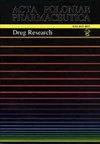培训前后波兰三年级大学听众对药物-食品相互作用的认知和知识——一项问卷研究
IF 0.4
4区 医学
Q4 PHARMACOLOGY & PHARMACY
引用次数: 0
摘要
药物与食物的相互作用问题是老年人特别关注的问题,因为多药治疗在这一人群中最为普遍。该研究旨在评估波兰第三年龄大学听众在接受该主题培训前后对药物与食物相互作用的认识和知识。共有143名参与者参加了这项研究,平均年龄为71.5±5.5岁。123名参与者(86%)完成了培训前后的问卷调查。91%的受访者听说食物会影响药物的有效性,同样数量的人表示他们知道什么时候服药。关于药物与食物相互作用的信息最常从医生(34%)、药物说明书(30%)或互联网文章(23%)获得。测试训练前后药物与食物相互作用知识的问题的平均正确答案率分别为32%和57%(p<0.05)。为了确定参数(或参数类别)之间的关系结构,使用对应分析(CA)对结果进行检验。指出了CA模型中具有最高表示质量的参数类别,并确定了以最高共存强度为特征的参数。大多数研究参与者都知道药物与食物的相互作用,但他们对这个主题的了解很差,而且往往是不正确的。培训大大增加了对药物与食物相互作用的了解。这项研究表明,有必要教育老年患者正确使用药物和食物,以及药物与食物相互作用的重要性。本文章由计算机程序翻译,如有差异,请以英文原文为准。
Awareness and knowledge of drug-food interactions among polish third-age university listeners before and after training – a questionnaire study
The problem of drug-food interactions is of particular concern to the elderly, as polypharmacy is most prevalent in this population. The study aimed to assess the awareness and knowledge of drug-food interactions among Polish third-age university listeners before and after training on that topic. A total of 143 participants, with a mean age of 71.5 ± 5.5 years, took part in the study. 123 participants (86%) completed the pre- and post-training questionnaires. 91% of respondents had heard that food can affect the effectiveness of drugs and a similar number stated that they are aware of what time to take their medications. Information about drug-food interactions was most frequently obtained from the physician (34%), the drug leaflet (30%), or the internet article (23%). The mean percentage of correct answers to questions testing knowledge of drug-food interactions before and after training was 32% and 57%, respectively (p < 0.05). To determine the structure of relationships between parameters (or categories of parameters), the results were examined using correspondence analysis (CA). The categories of parameters with the highest quality of representation in the CA model were indicated and the parameters characterized by the highest strength of coexistence were determined. The majority of study participants were aware of drug-food interactions, but their knowledge of the topic was poor, and often incorrect. The training significantly increased knowledge of drug-food interactions. The study indicates the need to educate geriatric patients on the correct use of drugs with food and on the importance of drug-food interactions.
求助全文
通过发布文献求助,成功后即可免费获取论文全文。
去求助
来源期刊
CiteScore
0.80
自引率
0.00%
发文量
74
审稿时长
6-12 weeks
期刊介绍:
The international journal of the Polish Pharmaceutical Society is published in 6 issues a year. The journal offers Open Access publication of original research papers, short communications and reviews written in English, in all areas of pharmaceutical sciences. The following areas of pharmaceutical sciences are covered: Analysis, Biopharmacy, Drug Biochemistry, Drug Synthesis, Natural Drugs, Pharmaceutical Technology, Pharmacology and General.
A bimonthly appearing in English since 1994, which continues “Acta Poloniae Pharmaceutica”, whose first issue appeared in December 1937. The war halted the activity of the journal’s creators. Issuance of “Acta Poloniae Pharmaceutica” was resumed in 1947. From 1947 the journal appeared irregularly, initially as a quarterly, then a bimonthly. In the years 1963 – 1973 alongside the Polish version appeared the English edition of the journal. Starting from 1974 only works in English are published in the journal. Since 1995 the journal has been appearing very regularly in two-month intervals (six books a year). The journal publishes original works from all fields of pharmacy, summaries of postdoctoral dissertations and laboratory notes.

 求助内容:
求助内容: 应助结果提醒方式:
应助结果提醒方式:


